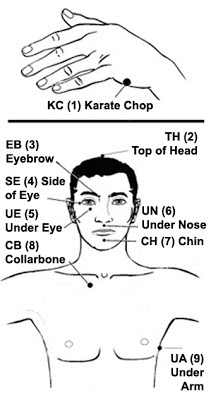The following is an excerpt from my e-book, "EFT for Self-Care: A Step-by-Step Guide for Beginners," available for FREE at
www.mindbodyglobal.com.
* EFT is not appropriate for use with mental health disorders and is not a substitute for mental health treatment from a licensed professional. If you have any concerns or are experiencing symptoms of a mental health disorder, please consult with your healthcare provider before engaging in this or any other self-care program.*
How to practice Emotional Freedom Technique
Keep a pencil and paper handy for each tapping session.
Step 1 - Identify the Problem
Select a problem you want to work on and a feeling that accompanies the problem. For example, if you are having trouble at work, your problem might be: “I am angry at my co-worker.”
Step 2 - Flesh out the Problem (Optional)
Dig a little deeper to get into the specific aspects of the issue. Perhaps you are angry because your co-worker did not do his or her share of the work on a joint project. If other feelings or thoughts come up, record them as well.
Step 3 - Establish a Baseline
Rate the intensity or level of distress associated with each thought and feeling on a scale of 0-10, zero indicating no distress at all and ten being the highest distress you can imagine. This is a SUDS scale (Subjective Units of Distress Scale).
For example, for this problem, you might feel frustration, fear of negative feedback, and anger. Record your level of distress next to each aspect.
Anger: 7
Frustration: 8
Fear: 6
Step 4
Prepare the statements you will use while tapping. Each statement should include an acknowledgement of a distressing thought or feeling you identified and an affirmation.
For example:
“Even though I am angry at my co-worker, I deeply and completely accept myself.”
For your affirmation you may also use phrases such as “I choose ...,” “I trust ...,” “I understand ...” and “I can learn to ....” Any positive statement that encourages health and self-acceptance is appropriate. You can address three separate aspects of your distress in three different statements, or repeat the same statement three times in your setup.
Step 5 Perform the Tapping sequence:
Your fingertips are an acupressure point, so make sure you are tapping with the tips of 3 or 4 of your fingers. Tap gently, quickly, and approximately seven times on each spot. Refer to the “Diagram of Tapping Points” found below:
Diagram of Tapping Points
Setup:
KC - karate chop. While repeating your statements, tap the sides of your fingers against the side of your hand. Either hand is fine, but stick with the same hand once you begin.
Then tap in the following order:
- EB - eyebrow
- SE - side of the same eye
- UE - under the same eye
- UN - under the nose
- CH - chin
- CB - collarbone
- UA - under the arm, just under the armpit
- TH - top of the head in a circle
While tapping on each point, highlight a specific aspect of your stress, such as “this anger,” “this fear,” “this frustration.” These are called “reminder phrases.” Go with the flow, tapping on what comes up. Let your instincts guide you. Complete at least one full sequence before pausing, and you may want to do two or three rounds of tapping before pausing.
Step 6: Pause and Reflect
When you pause, stop and ask yourself if anything new has come up. If yes, record these new thoughts and feelings and prepare new statements if needed. Don’t forget to take SUDS ratings for the new aspects of your stress.
Step 7: Continue Tapping
Tap a few more rounds, and when you feel you have made progress or it feels like it is an appropriate place to stop, go back to your statements and take SUDS ratings for each of them.
If your distress is decreasing, great! You may choose to continue working or decide that your stress is now at a manageable level.
If it is increasing, don’t worry or give up. Sometimes stress initially increases during EFT because we are giving a voice to our distressing thoughts and feelings. Although they are always lurking in the back of our minds, it can be unpleasant to acknowledge these thoughts and feelings. If you feel comfortable doing so, keep tapping! If you need to stop, use a debriefing tool such as five minutes of diaphragmatic breathing to decrease your level of distress before returning to your normal activities.
If you have been practicing EFT for a long time and your SUDS rating is not decreasing, there may be an underlying issue feeding the presenting problem, such as a previous experience or another layer of the problem. Ask yourself, “When have I experienced this before?” Or, “What else could this be about?” Go with whatever comes up, and begin tapping on that.
Remember that although EFT is safe to use on your own, it can be very powerful, especially if you uncover underlying issues or memories that are feeding your stress. It is very important to practice EFT in a safe place, perhaps with someone you trust, and that you have debriefing strategies you can use to calm yourself. If you feel uncertain about beginning this practice on your own, I invite you to contact me at www.mindbodyglobal.com for more information about 1:1 stress relief coaching with EFT.



